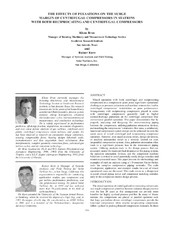| dc.contributor.other | Turbomachinery Symposium (38th : 2009) | |
| dc.creator | Brun, Klaus | |
| dc.creator | Kurz, Rainer | |
| dc.date.accessioned | 2017-10-04T21:23:09Z | |
| dc.date.available | 2017-10-04T21:23:09Z | |
| dc.date.issued | 2009 | |
| dc.identifier.uri | https://hdl.handle.net/1969.1/163094 | |
| dc.description | Special Paper | en |
| dc.description | pg. 239-250 | en |
| dc.description.abstract | Mixed operation with both centrifugal and reciprocating compressors in a compression plant poses significant operational challenges as pressure pulsations and machine mismatches lead to centrifugal compressors’ instabilities or poor performance. Arrangements with reciprocating compressors placed in series with centrifugal compressors generally lead to higher suction/discharge pulsations on the centrifugal compressor than conventional parallel operation. This paper demonstrates that by properly analyzing and designing the interconnecting piping between the compressors, utilizing pulsation attenuation devices, and matching the compressors’ volumetric-flow rates, a satisfactory functional compression system design can be achieved for even the worst cases of mixed centrifugal and reciprocating compressor operation. However, even small analysis errors design deviations, or machine mismatches result in a severely limited (or even inoperable) compression system. Also, pulsation attenuation often leads to a significant pressure loss in the interconnect piping system. Utilizing analysis tools in the design process that can accurately model the transient fluid dynamics of the piping system, the pulsation attenuation devices, and the compressor machine behaviors is critical to avoid potentially costly design mistakes and minimize pressured losses. This paper presents the methodology and examples of such an analysis using a 1-D transient Navier-Stokes code for complex compression piping networks. The code development, application, and example results for a set of mixed operation cases are discussed. This code serves as a design tool to avoid critical piping layout and compressor matching mistakes early in the compressor station process. | en |
| dc.format.medium | Electronic | en |
| dc.format.mimetype | application/pdf | |
| dc.language.iso | en | |
| dc.publisher | Texas A&M University. Turbomachinery Laboratories | |
| dc.relation.ispartof | Proceedings of the 38th Turbomachinery Symposium | en |
| dc.subject.lcsh | Turbomachines | en |
| dc.title | The Effects Of Pulsations On The Surge Margin Of Centrifugal Compressors In Stations With Both Reciprocating And Centrifugal Compressors. | en |
| dc.title.alternative | Effects Of Pulsations On The Surge Margin Of Centrifugal Compressors In Stations With Both Reciprocating And Centrifugal Compressors | en |
| dc.type.genre | Presentation | en |
| dc.type.material | Text | en |
| dc.identifier.doi | https://doi.org/10.21423/R1SW71 | |


